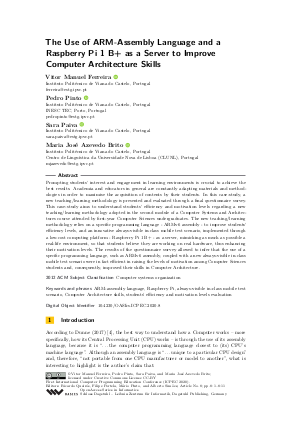The Use of ARM-Assembly Language and a Raspberry Pi 1 B+ as a Server to Improve Computer Architecture Skills
Authors
Vitor Manuel Ferreira  ,
Pedro Pinto
,
Pedro Pinto  ,
Sara Paiva
,
Sara Paiva  ,
Maria José Azevedo Brito
,
Maria José Azevedo Brito 
-
Part of:
Volume:
First International Computer Programming Education Conference (ICPEC 2020)
Part of: Series: Open Access Series in Informatics (OASIcs)
Part of: Conference: International Computer Programming Education Conference (ICPEC) - License:
 Creative Commons Attribution 3.0 Unported license
Creative Commons Attribution 3.0 Unported license
- Publication Date: 2020-06-15
File

PDF
OASIcs.ICPEC.2020.8.pdf
- Filesize: 2.89 MB
- 11 pages
Document Identifiers
Subject Classification
ACM Subject Classification
- Computer systems organization
Keywords
- ARM-assembly language
- Raspberry Pi
- always-visible in-class mobile test scenario
- Computer Architecture skills
- students' efficiency and motivation levels evaluation
Metrics
- Access Statistics
-
Total Accesses (updated on a weekly basis)
0Document
0Metadata
Abstract
Prompting students' interest and engagement in learning environments is crucial to achieve the best results. Academia and educators in general are constantly adapting materials and methodologies in order to maximise the acquisition of contents by their students. In this case-study, a new teaching/learning methodology is presented and evaluated through a final questionnaire survey. This case-study aims to understand students' efficiency and motivation levels regarding a new teaching/learning methodology adopted in the second module of a Computer Systems and Architectures course attended by first-year Computer Sciences undergraduates. The new teaching/learning methodology relies on a specific programming language - ARMv6 assembly - to improve students' efficiency levels, and an innovative always-visible in-class mobile test scenario, implemented through a low-cost computing platform - Raspberry Pi 1 B+ - as a server, mimicking as much as possible a real-life environment, so that students believe they are working on real hardware, thus enhancing their motivation levels. The results of the questionnaire survey allowed to infer that the use of a specific programming language, such as ARMv6 assembly, coupled with a new always-visible in-class mobile test scenario were in fact efficient in raising the levels of motivation among Computer Sciences students and, consequently, improved their skills in Computer Architecture.
Cite As Get BibTex
Vitor Manuel Ferreira, Pedro Pinto, Sara Paiva, and Maria José Azevedo Brito. The Use of ARM-Assembly Language and a Raspberry Pi 1 B+ as a Server to Improve Computer Architecture Skills. In First International Computer Programming Education Conference (ICPEC 2020). Open Access Series in Informatics (OASIcs), Volume 81, pp. 8:1-8:11, Schloss Dagstuhl – Leibniz-Zentrum für Informatik (2020)
https://doi.org/10.4230/OASIcs.ICPEC.2020.8
BibTex
@InProceedings{ferreira_et_al:OASIcs.ICPEC.2020.8,
author = {Ferreira, Vitor Manuel and Pinto, Pedro and Paiva, Sara and Brito, Maria Jos\'{e} Azevedo},
title = {{The Use of ARM-Assembly Language and a Raspberry Pi 1 B+ as a Server to Improve Computer Architecture Skills}},
booktitle = {First International Computer Programming Education Conference (ICPEC 2020)},
pages = {8:1--8:11},
series = {Open Access Series in Informatics (OASIcs)},
ISBN = {978-3-95977-153-5},
ISSN = {2190-6807},
year = {2020},
volume = {81},
editor = {Queir\'{o}s, Ricardo and Portela, Filipe and Pinto, M\'{a}rio and Sim\~{o}es, Alberto},
publisher = {Schloss Dagstuhl -- Leibniz-Zentrum f{\"u}r Informatik},
address = {Dagstuhl, Germany},
URL = {https://drops.dagstuhl.de/entities/document/10.4230/OASIcs.ICPEC.2020.8},
URN = {urn:nbn:de:0030-drops-122955},
doi = {10.4230/OASIcs.ICPEC.2020.8},
annote = {Keywords: ARM-assembly language, Raspberry Pi, always-visible in-class mobile test scenario, Computer Architecture skills, students' efficiency and motivation levels evaluation}
}
Author Details
References
- Patricio Bulić, Veselko Guštin, Damjan Šonc, and Andrej Štrancar. An FPGA-based integrated environment for computer architecture. Computer Applications in Engineering Education, 21(1):26-35, 2013. URL: https://doi.org/10.1002/cae.20448.
-
Seung Youn (Yonnie) Chyung, Katherine Roberts, Ieva Swanson, and Andrea Hankinson. Evidence-based survey design: The use of a midpoint on the likert scale. Performance Improvement, 56(10):15-23, 2017.

- A. Clements. ARMs for the poor: Selecting a processor for teaching computer architecture. In 2010 IEEE Frontiers in Education Conference (FIE), pages T3E-1-T3E-6, October 2010. URL: https://doi.org/10.1109/FIE.2010.5673541.
-
Robert Dunne. Assembly Language Using the Raspberry Pi: A Hardware Software Bridge. Gaul Communications, 2017.

- R. F. Ibáñez. ARM assembler in Raspberry Pi - Chapter 1,2,3,4 and 5, 2013. URL: https://thinkingeek.com/2013/01/09/arm-assembler-raspberry-pi-chapter-1/.
- R. F. Ibáñez and William J. Pervin. RASPBERRY PI ASSEMBLER. Online, 2017. URL: http://tiny.cc/v20m7y.
- G. Malhotra, N. Atri, and S. R. Sarangi. emuARM: A tool for teaching the ARM assembly language. In 2013 Second International Conference on E-Learning and E-Technologies in Education (ICEEE), pages 115-120, September 2013. URL: https://doi.org/10.1109/ICeLeTE.2013.6644358.
-
Muhammad Ali Mazidi, Sarmad Naimi, Sepehr Naimi, and Shujen Chen. ARM Assembly Language Programming & Architecture (Volume 1). MicroDigitalEd.com, 2013.

- MicroDigitalEd. ARM Assembly Programming Using Raspberry Pi GUI, 2017. URL: https://bit.ly/2JrkJaK.
- Robert G. Plantz. Introduction to Computer Organization: ARM Assembly Language Using the Raspberry Pi. Online, 2018. URL: http://bob.cs.sonoma.edu/IntroCompOrg-RPi/intro-co-rpi.html.
- Andrew S. Tanenbaum and Todd Austin. Structured Computer Organization. Pearson Prentice-Hall, New Jersey 07458, 6 edition, 2013. URL: https://goo.gl/N2YQc3.
-
Hamid S. Timorabadi. Reduced complexity processor for teaching computer architecture. In Proceedings of the Canadian Engineering Education Association (CEEA) Conference June 3-6, 2018 Vancouver BC, 2018.

